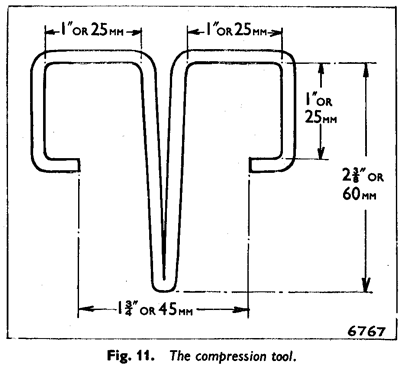|
COMPRESSION TOOL (Fig. 11)
The compression tool, necessary to compress the output piston, is made from a 12 in. (30 cm.) length oft in. (3 mm.) diameter iron wire.
Bend the wire back on itself in the centre to make the middle leg of the tool. Follow with the six other bends as shown in the illustration, finally cutting the two ends so there is 1~ in. (45 mm.) between them.
The centre leg is inserted into the output cylinder bore and pressed down until the two ends can be sprung apart and clipped under the mounting flange of the cast body. The tool is then pushed aside towards the control cylinder bore to allow room to insert the circlip pliers.
TESTING EQUIPMENT
To make comprehensive tests, of the vacuum servo unit, requires complex and expensive equipment and this kind of testing is outside the capacity of many Service Workshops.
A number of simple tests can be made when the servo unit is installed which gives some useful information and these tests are described hereafter. The only piece of equipment required is a 3" X 24 U.N.F. pipe union to fit into the hydraulic inlet port.
The use of these tests will assist in diagnoses and will provide assurance after servicing, but the tests are not exhaustive and so cannot equal the standard of the testing which is done in the factory by the specially designed |
equipment. If a vacuum servo unit gives cause for doubt it is always best to replace it with a factory tested unit when ever possible.
IT IS ASSUMED THAT ANY FAULTS CONNECTED WITH THE BRAKE SYSTEM, SUCH AS FLUID CONTAMINATION, LACK OF ADJUSTMENT, AIR IN THE HYDRAULIC SYSTEM, FLUID LEAKS, ETC., HAVE BEEN RECOGNISED AND ELIMINATED.
TEST 1
1. Fit the servo unit to the mounting bracket and before connecting the air or fluid pipes, fit a bleed screw to the fluid outlet port and the special adaptor to the fluid inlet port.
2. Connect the vacuum pipe from the engine inlet manifold to the adaptor and remove the air filter element.
3. Start the engine and while ticking over place the fingers over the air inlet port of the air filter and the vacuum port to determine if there Is any suction at either orifice.
4. If suction can be detected, it indicates that the bores are scored or the components incorrectly assembled.
5. Remove the adaptor.
Test 2
1. Connect the vacuum pipe from the inlet manifold to the vacuum port.
2. Connect the fluid inlet and outlet pipes to their respective ports and bleed the hydraulic system of air.
3. Start and run the engine. While the brake is being applied, it should be possible to hear the hiss of the air inlet and with the hand on the vacuum cylinder feel the movement of the piston inside the vacuum cylinder.
Test 3
1. Start and run the engine for half a minute then switch off and leave for two minutes.
2. Apply the brake and the servo unit should operate and the operation should be detected as described in Test 2.
Test 4
Start and run the engine, apply the brake hard and hold it on for fifteen to twenty seconds. There should be no perceptible creep in the brake pedal. If there is any creep, it indicates leaks or scored bores in the components. |
 **
**
